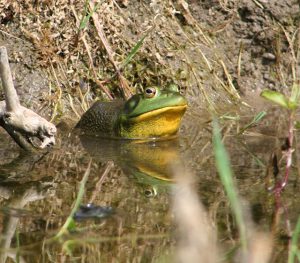Northern Leopard Frog preservation: American Bullfrog control
This project aims to conduct a comprehensive and targeted surveillance and eradication program on American Bullfrogs. The intent of this project is to protect the productivity of the wetland ecosystem and habitats on which the Northern Leopard Frog is directly dependent, from the specific threat that is being generated by the arrival of the highly invasive American Bullfrog. Eradicating bullfrogs will enhance potential pond habitat for Northern Leopard Frogs, as bullfrogs are an obligate aquatic species known to occupy a wide range of habitats including lakes, ponds, swamps, bogs, backwaters, reservoirs, marshes, streams, irrigation ponds, and ditches. In addition, bullfrog tadpoles are considered to be ‘‘ecosystem engineers,’’ altering the biomass, structure, and composition of algal communities.
Bullfrogs threaten Northern Leopard Frogs

For nearly twenty years, the FWCP has been funding work to conserve Northern Leopard Frogs in the Creston Valley. Results have been positive, with some success in re-introducing this endangered species to its historical range in the East Kootenay. But now the aggressive and voracious American Bullfrog has arrived, creating a direct threat to native fish, salamanders, snakes, lizards, birds, turtles, and endangered Northern Leopard Frogs.
Right now, there is an established (reproducing) population of bullfrogs south of Salmo. More recently, adult bullfrogs – no tadpoles yet – have been recorded north of the Rykerts border crossing, about 13 kilometres south of Creston.
With funding from the FWCP, the Central Kootenay Invasive Species Society (CKISS), together with the Northern Leopard Frog Recovery Team, the Province of B.C., and other partners, are working on three fronts to reduce the threat of Bullfrogs:
- surveillance
- eradication, and
- education.
Surveillance: Surveillance includes visual and acoustic monitoring, and environmental DNA testing of water samples to detect Bullfrog presence.
Eradication: In 2017, eradication was successfully completed in five sites, where the captured Bullfrogs were euthanized in accordance with Canadian Council for Animal Care guidelines. Project partners are aware, however, that eradication from these sites may be temporary, as more Bullfrogs continue to push up from Idaho.
Education: Public outreach and education undertaken by CKISS to raise awareness about American Bullfrogs led to the first confirmed sighting of this species in Creston. CKISS will build on previous communication successes, and expand landowner outreach in the Creston Valley in 2018.
Update: Nearly 500 Bullfrogs detected in the Creston Valley
In the Creston Valley, extensive surveillance activities were conducted to detect bullfrog presence. Positive detection of an estimated 477 bullfrogs, of all age and sex classes, occurred as a result of visual surveillance, and 454 bullfrogs were captured and subsequently euthanized. The detection of tadpoles and metamorphs in 2018 confirmed for the first time that breeding has occurred in this area. Bullfrog presence was not detected by means of passive acoustic recording devices; however, bullfrog calls were audibly detected by field staff in an area where bullfrog presence was not previously known to occur. The Central Kootenay Invasive Species Society (CKISS) delivered a comprehensive education and outreach program through various in-person activities, such as community events, presentations, and field trips, as well as through mass and social media. Monitoring and control work conducted in 2018 revealed the bullfrog infestation to be much wider spread than initially anticipated, and CKISS recommends that a coordinator be hired who is dedicated solely to the management of the bullfrog control program.
Final report: executive summary
American bullfrogs (Lithobates catesbeianus) pose a significant threat to the biodiversity of waterbodies in the Central Kootenay Invasive Species Society operational region, and to the survival of the endangered northern leopard frog (Lithobates pipiens) population of the Creston Valley. Improvements to habitat conditions and ecosystem function for northern leopard frog and other species at risk were undertaken through extensive surveillance and eradication actions on American bullfrog. This project aligns with the Riparian and Wetlands Action Plan, with the primary actions of monitoring and treating aquatic invasive species in wetland and riparian areas, and supporting the development of management plans for wetlands in this focal area, including but not limited to the Yaqan Nuki wetlands. In addition, northern leopard frog is defined as a recovery species within the Species of Interest Action Plan.
Click the provincial database link below to read the full final report for this project.


